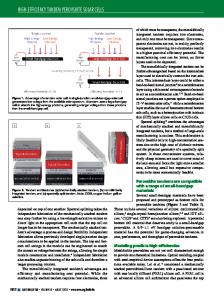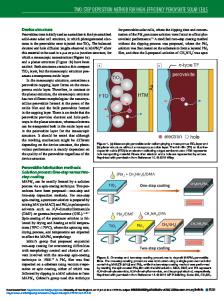Mechanism of Photoanodes for Dye-Sensitized and Perovskite Solar Cells
The demand for fossil fuel consumption is continuously increasing due to the growth of the world’s population. Carbon dioxide (CO2) gas emission from conventional energy sources eventually will amplify the Earth’s natural “greenhouse” effect and hence wil
- PDF / 754,457 Bytes
- 20 Pages / 439.37 x 666.142 pts Page_size
- 54 Downloads / 395 Views
Contents 1 Introduction 1.1 Background and Motivation 1.2 Photovoltaic Cells (PVs) 1.3 Overview of Organic Photovoltaic Cells 2 Material Selection 3 Photoanode Preparation Methods
F. W. Low (*), S. Mahalingam, M. Shakeri, C. T. Yaw, N. A. Samsudin, N. Amin, S. K. Tiong, and C. K. Hen Institute of Sustainable Energy, Universiti Tenaga Nasional (The Energy University), Jalan IKRAM-UNITEN, Kajang, Selangor, Malaysia e-mail: [email protected] S. M. Goh College of Engineering, Universiti Tenaga Nasional (The Energy University), Jalan IKRAMUNITEN, Kajang, Selangor, Malaysia A. Manap Institute of Sustainable Energy, Universiti Tenaga Nasional (The Energy University), Jalan IKRAM-UNITEN, Kajang, Selangor, Malaysia Department of Mechanical Engineering, College of Engineering, Universiti Tenaga Nasional (@The Energy University), Jalan IKRAM-UNITEN, Kajang, Selangor, Malaysia J. Pasupuleti Institute of Sustainable Energy, Universiti Tenaga Nasional (The Energy University), Jalan IKRAM-UNITEN, Kajang, Selangor, Malaysia College of Engineering, Universiti Tenaga Nasional (The Energy University), Jalan IKRAMUNITEN, Kajang, Selangor, Malaysia
Pankaj Pathak and Rajiv Ranjan Srivastava (eds.), Alternative Energy Resources: The Way to a Sustainable Modern Society, Hdb Env Chem, DOI 10.1007/698_2020_633, © Springer Nature Switzerland AG 2020
F. W. Low et al. 3.1 Chemical Methods 3.2 Physical Methods 4 Mechanism of Dye-Sensitized Solar Cells 5 Mechanism of Perovskite Solar Cells 6 Conclusions References
Abstract The demand for fossil fuel consumption is continuously increasing due to the growth of the world’s population. Carbon dioxide (CO2) gas emission from conventional energy sources eventually will amplify the Earth’s natural “greenhouse” effect and hence will result in global warming. Therefore, to reduce the risk of climate change, photovoltaic solar cell (PV) devices have been developed. Surprisingly, PV system has capability to conduct useful electricity from natural sunlight source, which provides clean, sustainable, and renewable energy instead of combusted conventional fossil fuel sources. Nowadays, both dye-sensitized cells (DSSCs) and perovskite solar cells (PSCs) were investigated more intensively than the first- and second-generation solar cell systems due to their flexibility, transparency, and lighter weight materials. In fact, photoanode elements played an essential role in determining the strength of light-harvesting absorption and generating excited electron charge carriers’ mobility between dye/perovskite and respective transparent conductive oxide (TCO) glasses. Apart from that, binary/ternary transition metal oxide material selection (TiO2, ZnO, SnO2, MgO, WO3, etc.) of photoanode in DSSCs and PSCs is also a crucial factor for photogenerated electrons. However, still metal oxide materials have some drawbacks such as high recombination rate which resulted in losses of overall photoenergy conversion efficiency (PCE) performance. In fact, the PCE of existing either DSSC or PSC devices still have rooms to improv
Data Loading...











